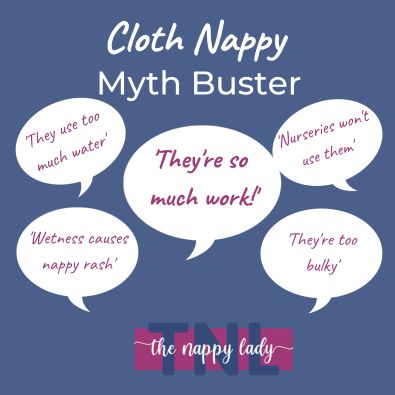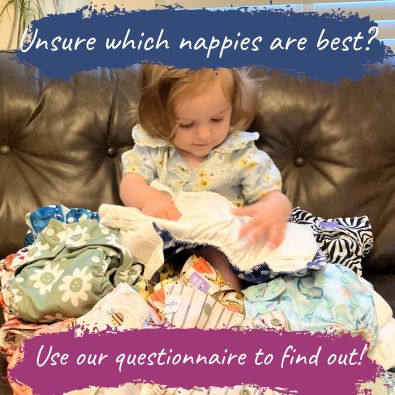Cloth Nappy Myths

The minute you tell people you are considering using cloth nappies, you’ll very likely be met with a barrage of objections. They may come from well meaning relatives who may remember plastic pants, boil washing and soaking, or from someone who has only heard the information second hand. Here are a few of the most common ones, along with some suitable replies (assuming you decide to avoid the simple 'what a load of rubbish', which is unlikely to win friends and influence people).
All of these issues have been addressed elsewhere on the site, usually in more detail. This page is simply designed as an easy crib sheet, so you to have a handy response to the negative comments from the people you discuss this issue with. Of you could just point them to this website and ask them to take the trouble of informing themselves as thoroughly as you have decided to do!
"Cloth nappies are just as bad for the environment as disposables"
In the past, claims to this effect made by Procter and Gamble were challenged before the Advertising Standards Authority by the Women's Environmental Network. The challenge was upheld, and P&G are not permitted to repeat them.
In 2005, an Environment Agency report which came out claiming that there is no overall environmental difference between cloth nappies and disposables. This quote has been much used by the disposables industry and the media, although the word 'overall' tends to be omitted.
There are two major points to be made about this report. Firstly, the sample of disposables users was 2000, whereas the sample of cloth nappy users was only 32. Of those 32, some were not relevant in answering some of the questions. So cloth nappy usage statistics have been extrapolated from no more than 32 and in some cases as few as 2 responses. Hardly statistically valid! So the data extracted must be used with extreme caution.
Secondly, the report did draw one very useful conclusion, which the media and the disposables industry have chosen to ignore, as far as telling consumers is concerned: the overall environmental impacts of the two nappy systems are different - with disposables it is largely waste and landfill; with cloth nappies it is largely energy, water and detergents.
And the main conclusion of the report was that the onus is on the disposables manufacturers to reduce the environmental impact of their product, whereas it is on the users to reduce the environmental impact of cloth nappies. No one is forcing you to boil wash, to tumble dry or to iron. Take those out of the equation, and cloth nappy environmental impact goes right down. And, luckily, the kind of people who typically choose cloth nappies are exactly the kind of people who would be aware of their environmental obligations in this regard.
The environmental costs of using cotton nappies can be substantially minimised by the parent in their decisions on whether to soak, how frequently to wash, whether to tumble dry etc. Parents have very little control over the environmental costs of disposables.
Read more details on the environmental impact of nappies here.
"Cloth nappies are a lot of hard work"
If you can wash a tea towel, you can wash a nappy. What’s the difference? Modern cloth nappies do up with velcro, poppers or nifty little grips (nappi nippas), and many are shaped just like disposables. Yes, you may need to put on a separate waterproof wrap, but is it any different to dressing a child in a vest then a T-shirt on top? It’s up to you whether you just fling the nappies in the nappy bucket, or whether you rinse them out first, pick whichever suits your own temperament.
Nappies and many wraps just go in the wash at 60. No need to soak or to boil wash. The hardest thing is to get into a routine - many people simply alternate clothes washes with nappy washes.
Below is an article written by one of our customers, sharing their experience when starting with reusable nappies.
Gosh all that work for nappies!!
This is perhaps the commonest reaction I get when I share our clothbum journey with others. The reality is once upon a time cloth nappies WERE a lot of work. My mum often tells me stories of hand washing my dirty nappies and even boiling them on the stove to get rid of smells! Thankfully things have moved leaps and bounds in the cloth nappy world
When disposable were first introduced, they were done so as the 'easy option' and they are. But at what cost? Our Planet? We live in a world where using a plastic straw can raise eyebrows but disposable nappies are the accepted norm. Why? Each day in the UK alone, eight million disposable nappies are thrown away and sent to landfill where they take up to 500 years to degrade. At landfill disposable emit harmful greenhouse gases which contributes to climate change.
The reality is I find cloth nappies marginally extra work. I have three children and what's really added to my routine is a few extra washes a week and some extra folding and sorting nappies time. I barely notice this amidst the mountains of laundry I do and I think its a small adjustment to make in doing my bit for #mothernature
What I have noticed is that on the odd occasion or two where we've opted for disposable for 'ease of use' we have regretted it. They have resulted in up the back poonamis which are FAR MORE work to clean than using cloth. We've never had this issue with cloth, ever. I’ll take an extra load of washing over this any day.
I often describe using cloth nappies a bit like cooking from scratch. Yes, it takes a bit more time to wash, dry and fold, but in the end it's totally worth it.
"Wetness causes nappy rash"
If this were true, all children in cloth nappies would have nappy rash and no children in disposables would do. Even Kimberley-Clark, makers of Huggies nappies, admit that over 50% of children (presumably mostly in disposables) have nappy rash at any one time (source: European attitudes survey by Kimberley-Clark, used in advertising material in 2000).
Parents using cloth nappies are usually evangelical about their benefits - why would they do this if using them gave their children nappy rash? Independent university research found that the stay dry layer of disposable nappies offered 'little or no protective effect' against severe nappy rash, which is effectively an admission that the wetness myth is exactly that.
In fact, it isn't wetness itself that causes nappy rash. With a wet nappy only, there is no real risk of nappy rash developing. However, as soon as they have had a poo, the bacteria in the faeces reacts with stale urine on the skin to produce ammonia. It is this that irritates the skin and causes nappy rash to develop. Changing nappies frequently - cloth or disposable - will minimise the chances of a rash happening.
Read our full article on nappy rash here.
"They make children bandy legged"
Are you or your parents bandy legged? The chances are, if you were born before the late 1970's you were all raised in old-fashioned terries. Yes, children in cloth nappies may well walk slightly differently from their peers in disposables, and lie with their legs more splayed, but they are not bandy legged. Some paediatricians argue that the extra support of cloth provides better conditions for proper hip development, as well as spinal cushioning while the child learns to walk.
"Disposables help children walk better or sooner"
It is vaguely possible that your child may become mobile a few weeks earlier in disposables than they would in cloth, but of course it is impossible to prove. There are plenty of early walkers in cloth nappies and plenty of late walkers in disposables. The truth is, your child will walk when they are ready to, and there is no norm at all. The earlier a child becomes mobile, the less safe they are in their environment, because the less developed their sense of danger and the less control they have over their limbs. A crawling 6 month old is far more likely to have an accident than a crawling 10 month old. So, even if cloth nappies were to slow the process up by a few weeks, so what?
Read more about cloth nappies and hip development here.
"Nappy buckets stink your house out"
All nappy buckets are lidded, and any poo in the nappies is flushed into the sewage system before they go in the bucket, so there is absolutely no reason for there to be any smell outside the bucket. There will be a bit more smell in the nappy bucket if you choose to soak, but it should not escape the lid. The nappy bucket will normally be emptied every 2nd or at the most 3rd day, unlike a bin full of faeces-filled disposables sitting there for up to a week (two in some areas, where they are trying to make people more aware of the waste they create by increasing collection times). Check out the bin at a disposables-using household if you want to know what stinky nappies are really like!
"Nurseries or childminders won’t use them"
Anyone officially caring for your child is obliged to meet any reasonable request by the parents, and cloth nappies fall into this category. If a nursery seems unwilling or claims that they are not allowed to use cloth nappies, their Special Needs or Equal Opportunities policies will normally prove otherwise. Having said that, good daycare is hard to come by, and it may be necessary for cloth-using parents to compromise if they come to a serious objection.
New to cloth? Let us help you find what will work best
Take our cloth nappy questionnaire today and let us help you get started.
